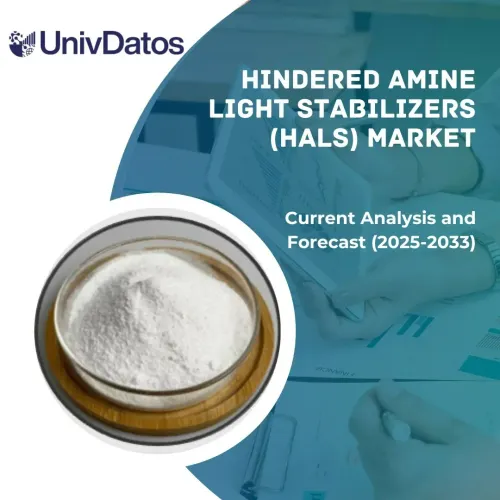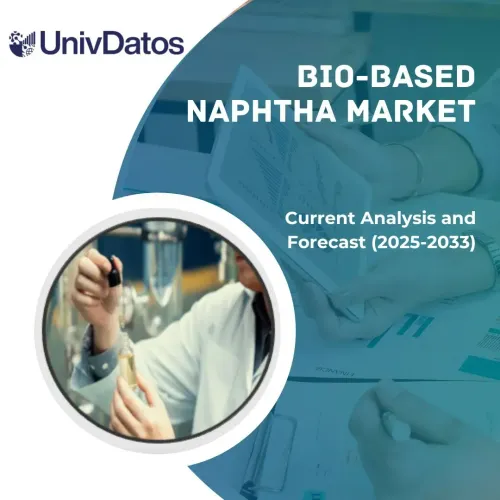Рынок пожарной пены – глобальный отраслевой анализ, размер, доля, рост и прогноз (2022-2028)
Акцент на типе (пленкообразующая пена (AFFF), спиртостойкая пленкообразующая пена (AR-AFFF), протеиновая пена (PF), пена из синтетических моющих средств (среднего и высокого расширения) и другие); конечный пользователь (нефть и газ, авиация, нефть и нефтехимия, морской транспорт, горнодобывающая промышленность и другие); и регион/страна
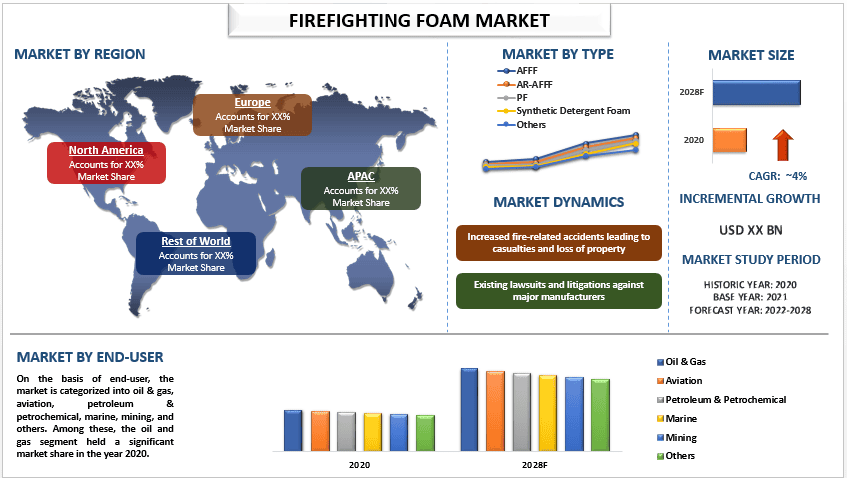
Ожидается, что мировой рынок пожарной пены вырастет значительными темпами, примерно на 4% в течение прогнозируемого периода.Пожарная пена известна как стабильная масса мелких, низкой плотности, заполненных воздухом пузырьков. Она образует постоянный пенный покров, который распространяется по топливу и прилипает к различным поверхностям, предотвращая контакт между огнем и кислородом. Кроме того, в отличие от других огнетушащих веществ, таких как сухие химикаты, вода или углекислый газ (CO2), огнетушащая пена охлаждает и отделяет пламя от поверхностей продукта, а также подавляет и удушает пары, тем самым снижая воспламеняемость и горючесть для тушения жидкости. Следовательно, она широко используется в областях, где легковоспламеняющиеся жидкости транспортируются, перерабатываются, хранятся и используются в качестве источников энергии.
Johnson Controls International, Dr. Sthamer, SFFECO Global, DIC Corporation, Dafo Fomtec AB, Angus Fire, Kerr Fire, Perimeter Solutions, National Foam и Chemguard являются одними из ключевых игроков на рынке. Этими игроками были предприняты несколько слияний и поглощений, а также партнерства для предоставления клиентам высокотехнологичных и инновационных продуктов/технологий.
Информация, представленная в отчете
«Среди типов, категория пленкообразующей пены (AFFF) будет демонстрировать устойчивый среднегодовой темп роста в течение прогнозируемого периода»
В зависимости от типа, рынок сегментирован на пленкообразующую пену (AFFF), спиртостойкую пленкообразующую пену (AR-AFFF), протеиновую пену (PF), пену из синтетических моющих средств (среднего и высокого расширения) и другие. Категория пленкообразующей пены (AFFF) показала более высокий среднегодовой темп роста в течение прогнозируемого периода благодаря своим свойствам огнетушащего вещества, состоящего из фторопласта, фторосурфактанта, водорастворимого полимера и углеводородного поверхностно-активного вещества. Кроме того, высокий спрос в нефтегазовой отрасли из-за высокого риска пожаров от легковоспламеняющихся жидкостей. Более того, эти пены подходят для немедленного тушения пожаров класса B, включая пожары с участием полярных растворителей, таких как кетоны и спирт, что стимулирует рост рынка.
«Среди конечных пользователей, сегмент нефти и газа будет удерживать значительную долю на рынке в 2020 году»
На основе конечного пользователя рынок делится на нефть и газ, авиацию, нефть и нефтехимию, морской транспорт, горнодобывающую промышленность и другие. Среди них сегмент нефти и газа будет удерживать значительную долю на рынке в 2020 году. Это в основном связано с тем, что он является одним из крупнейших потребителей пожарной пены на рынке, поскольку эта пена широко используется для пожаров класса B и является лучшим решением противопожарной защиты для пожаров, вызванных легковоспламеняющимися жидкостями. Кроме того, легковоспламеняющиеся жидкости и газы могут привести к серьезному материальному ущербу, загрязнению окружающей среды и серьезным пожарным опасностям, которые угрожают жизни. Следовательно, многие пожары на нефтяных скважинах могут привести к потере миллионов баррелей сырой нефти в день, что приведет к огромным экономическим потерям. Следовательно, в последние годы увеличился спрос на продукцию со стороны нефтегазовой отрасли, что усиливает рост рынка.
Обзор отчета о рынке пожарной пены
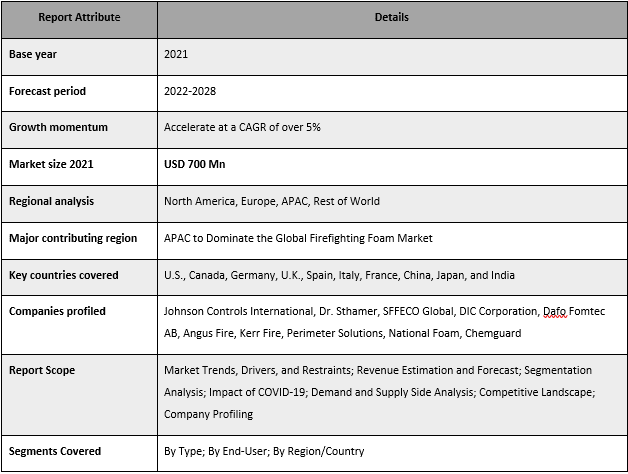
«APAC будет расти со значительным среднегодовым темпом роста в течение прогнозируемого периода»
В 2020 году ожидается, что APAC будет расти со значительным среднегодовым темпом роста в течение прогнозируемого периода. Это в основном связано с постоянно расширяющимся использованием в нефтегазовой отрасли, которая является растущей отраслью в этом регионе. Кроме того, в регионе наблюдается быстрый рост таких отраслей, как химическая, судоходная, автомобильная и аэрокосмическая промышленность в таких странах с развивающейся экономикой, как Китай и Индия. Более того, на регион APAC приходится большая часть мирового химического производства, и он подвержен пожарам из-за небезопасных работников. Кроме того, сухие погодные условия привели к пожарам в различных странах региона, а лесные пожары продолжают наносить дальнейший ущерб окружающей среде, средствам к существованию и экономике, что стимулирует рост рынка в регионе.
Причины купить этот отчет:
- Исследование включает в себя оценку размера рынка и анализ прогнозирования, подтвержденные аутентифицированными ключевыми отраслевыми экспертами.
- Отчет представляет собой краткий обзор общей эффективности отрасли с первого взгляда.
- Отчет содержит углубленный анализ выдающихся отраслевых коллег с основным упором на ключевые финансовые показатели бизнеса, продуктовый портфель, стратегии расширения и недавние разработки.
- Детальное изучение движущих сил, ограничений, ключевых тенденций и возможностей, преобладающих в отрасли.
- Исследование всесторонне охватывает рынок по различным сегментам.
- Углубленный анализ отрасли на региональном уровне.
Варианты настройки:
Мировой рынок пожарной пены может быть дополнительно настроен в соответствии с требованиями или любым другим сегментом рынка. Кроме того, UMI понимает, что у вас могут быть свои собственные бизнес-потребности, поэтому не стесняйтесь связаться с нами, чтобы получить отчет, который полностью соответствует вашим требованиям.
Содержание
Методология исследования для анализа рынка пожарной пены (2022-2028)
Анализ исторического рынка, оценка текущего рынка и прогнозирование будущего рынка мирового рынка пожарной пены были тремя основными шагами, предпринятыми для создания и анализа внедрения пожарной пены в основных регионах мира. Были проведены исчерпывающие вторичные исследования для сбора исторических рыночных показателей и оценки текущего размера рынка. Во-вторых, чтобы подтвердить эти данные, были приняты во внимание многочисленные выводы и предположения. Кроме того, были проведены исчерпывающие первичные интервью с отраслевыми экспертами по всей цепочке создания стоимости мирового рынка пожарной пены. После предположения и подтверждения рыночных показателей посредством первичных интервью мы применили подход сверху вниз/снизу вверх для прогнозирования полного размера рынка. После этого были приняты методы разбивки рынка и триангуляции данных для оценки и анализа размера рынка сегментов и подсегментов отрасли. Подробная методология объяснена ниже:
Анализ исторического размера рынка
Шаг 1: Углубленное изучение вторичных источников:
Было проведено детальное вторичное исследование для получения исторических размеров рынка пожарной пены через внутренние источники компании, такие какгодовые отчеты и финансовая отчетность, презентации о производительности, пресс-релизы и т. д.,и внешние источники, включаяжурналы, новости и статьи, правительственные публикации, публикации конкурентов, отраслевые отчеты, сторонние базы данных и другие авторитетные публикации.
Шаг 2: Сегментация рынка:
После получения исторического размера рынка пожарной пены мы провели детальный вторичный анализ для сбора исторических данных о рынке и доли для различных сегментов и подсегментов для основных регионов. Основные сегменты включены в отчет как тип и конечный пользователь. Кроме того, были проведены анализы на уровне стран для оценки общего внедрения моделей тестирования в этом регионе.
Шаг 3: Факторный анализ:
После приобретения исторического размера рынка различных сегментов и подсегментов мы провели детальныйфакторный анализдля оценки текущего размера рынка пожарной пены. Далее мы провели факторный анализ с использованием зависимых и независимых переменных, таких как различные типы и конечный пользователь пожарной пены. Был проведен тщательный анализ сценариев со стороны спроса и предложения с учетом ведущих партнерств, слияний и поглощений, расширения бизнеса и запуска продуктов в секторе рынка пожарной пены по всему миру.
Оценка и прогноз текущего размера рынка
Определение текущего размера рынка:Основываясь на практических данных, полученных в результате вышеуказанных 3 шагов, мы пришли к текущему размеру рынка, ключевым игрокам на мировом рынке пожарной пены и рыночным долям сегментов. Все требуемые доли в процентах, разбивки и разбивки рынка были определены с использованием вышеупомянутого вторичного подхода и были проверены посредством первичных интервью.
Оценка и прогнозирование:Для оценки и прогнозирования рынка были назначены веса различным факторам, включая движущие силы и тенденции, ограничения и возможности, доступные для заинтересованных сторон. После анализа этих факторов были применены соответствующие методы прогнозирования, т. е. подход сверху вниз/снизу вверх, для получения прогноза рынка на 2028 год для различных сегментов и подсегментов на основных рынках мира. Методология исследования, принятая для оценки размера рынка, включает:
- Размер рынка отрасли в терминах выручки (USD) и уровень внедрения рынка пожарной пены на основных рынках внутри страны
- Все процентные доли, разбивки и разбивки сегментов и подсегментов рынка
- Ключевые игроки на мировом рынке пожарной пены с точки зрения предлагаемой продукции. Кроме того, стратегии роста, принятые этими игроками для конкуренции на быстрорастущем рынке
Подтверждение размера и доли рынка
Первичное исследование:Были проведены углубленные интервью с ключевыми лидерами мнений (KOL), включая руководителей высшего звена (CXO/VP, руководители по продажам, руководители по маркетингу, руководители операций, региональные руководители, руководители стран и т. д.) в основных регионах. Затем были обобщены результаты первичных исследований и проведен статистический анализ для подтверждения заявленной гипотезы. Данные первичных исследований были консолидированы со вторичными данными, таким образом, превращая информацию в практические выводы.
Разбивка основных участников по различным регионам
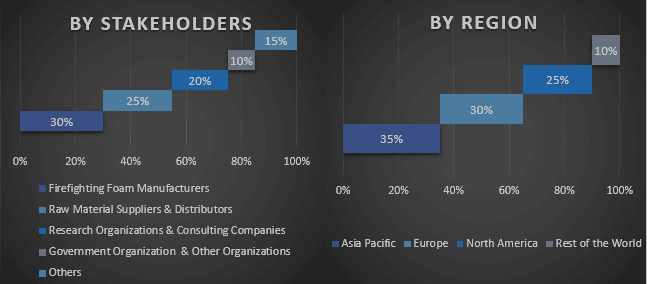
Инженерия рынка
Для завершения общей оценки рынка и получения точных статистических данных по каждому сегменту и подсегменту мирового рынка пожарных пен была применена методика триангуляции данных. Данные были разделены на несколько сегментов и подсегментов после изучения различных параметров и тенденций в областях типов и конечных пользователей на мировом рынке пожарных пен.
Основная цель исследования мирового рынка пожарных пен
В исследовании были определены текущие и будущие рыночные тенденции мирового рынка пожарных пен. Инвесторы могут получить стратегические выводы для обоснования своих инвестиционных решений на основе качественного и количественного анализа, проведенного в исследовании. Текущие и будущие рыночные тенденции определили общую привлекательность рынка на региональном уровне, предоставив участникам отрасли платформу для использования неиспользованного рынка, чтобы извлечь выгоду из преимущества первого хода. Другие количественные цели исследований включают:
- Анализ текущего и прогнозируемого размера рынка пожарных пен в стоимостном выражении (USD). Кроме того, анализ текущего и прогнозируемого размера рынка различных сегментов и подсегментов
- Сегменты в исследовании включают области типов и конечных пользователей.
- Определение и анализ нормативно-правовой базы для индустрии пожарных пен.
- Анализ цепочки создания стоимости с учетом присутствия различных посредников, а также анализ поведения клиентов и конкурентов отрасли.
- Анализ текущего и прогнозируемого размера рынка пожарных пен для основного региона.
- Основные страны регионов, изученные в отчете, включают Азиатско-Тихоокеанский регион, Европу, Северную Америку и остальной мир.
- Профили компаний на рынке пожарных пен и стратегии роста, принятые участниками рынка для удержания на быстрорастущем рынке
- Детальный анализ отрасли на региональном уровне
Связанные Отчеты
Клиенты, купившие этот товар, также купили

